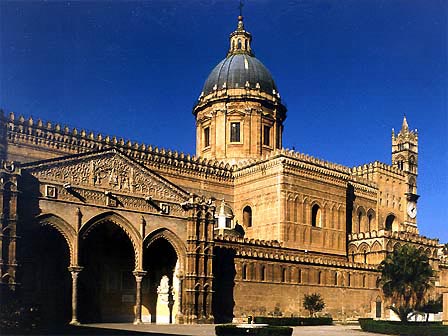
The Cathedral

| This
magnificent and imposing religious building was erected on the site of
the old cathedral, built by St Gregory the Great in 603, transformed
into a mosque by the Arabs and reconsecrated to the Christian cult by
the Norman kings. The present building was founded by Gualtiero
Offamilio (Walter of the Mill), Archbishop of Palermo from 1168 to 1193,
during the reign of the Norman king William II, known as the Good. Even
though the original structures have remained unaltered throughout the
centuries, the construction underwent several additions and alterations
between the 14C and the 16C. Between 1781 and 1801 the architect
Fernando Fuga transformed the Latin cross basilical plan adding the side
aisles, the wings of the transept and the majestic dome. Since the days
of its construction, the Cathedral has witnessed some of the most
important events in the history of the city and of the entire island.
Here the Norman and Swabian kings were crowned and buried in the
Imperial Tombs. Here in the Santa Rosalia Chapel, the relics of the
patron saint of the are contained in a sumptuous silver urn. |
|
||||||
|
The
interior of the Cathedral was transformed between 1781 and 1801 and
given its present neoclassical appearance. It has a Latin cross
basilican plan, with a nave and two aisles divided by pillars; the
archivolted interior incorporates granite columns from the pre-existing
church. The nave is covered by a bright barrel vault and flanked by a
row of marble statues of Saints placed on each pillar and in the
transept. |